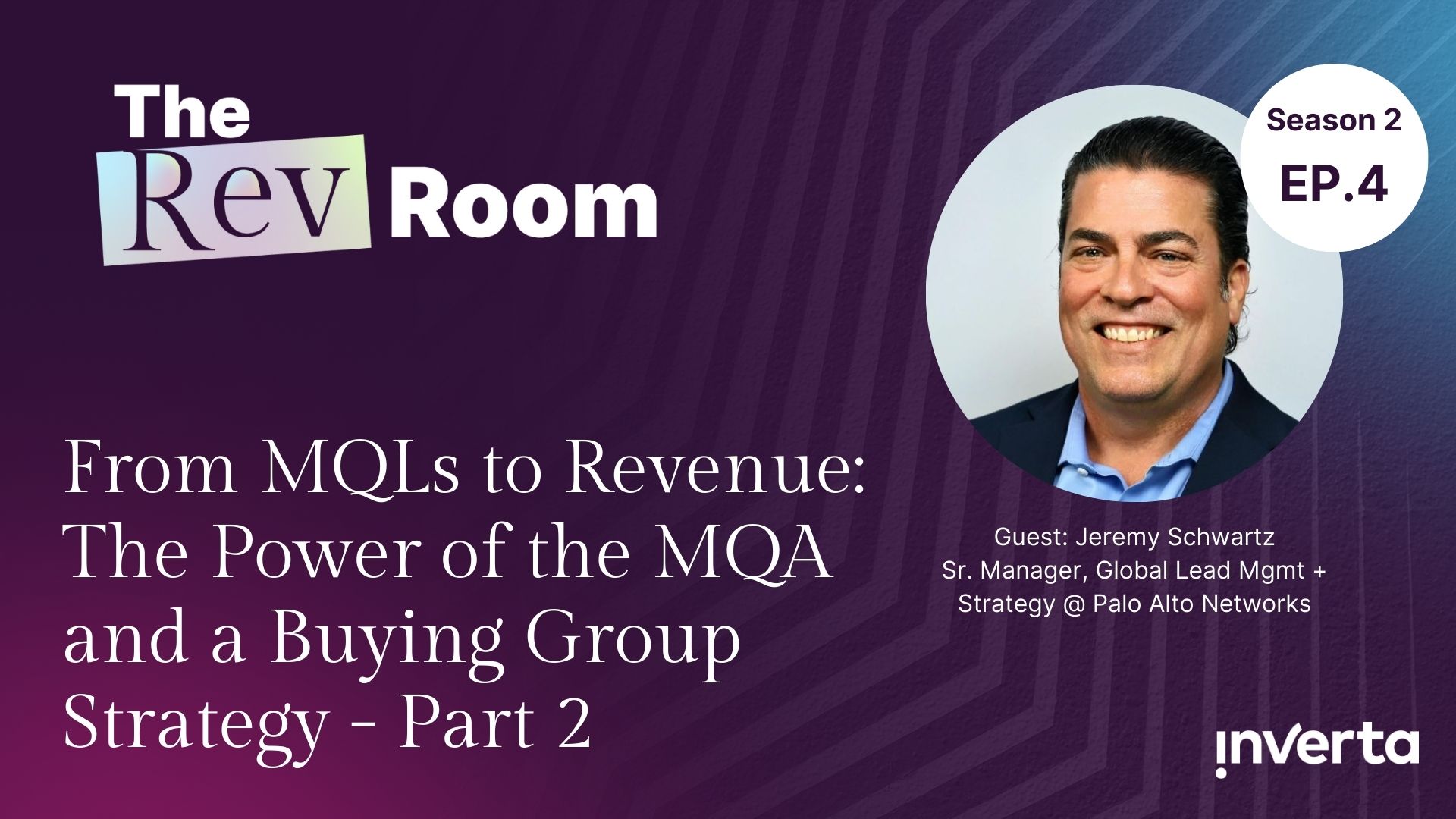From MQLs to Buying Groups: Palo Alto’s Transformation


In partnership with:
Featuring
Featuring
How are you going to stand out in 2026?
Buyers are in control of the buying process. Over 70% of it is happening online. And they are putting companies on their short list of vendors that provide value and establish trust with their content.
How are you accounting for this in your 2026 strategy?
You need to stand out. To make sure your buyers notice you. Let us help you build that into your strategy for next year -->

The Revenue Marketer

From MQLs to Buying Groups: Palo Alto’s Transformation
Still chasing 10% efficiency gains?
2023-2025 were the years of experimentation with AI. 2026 is the year to make it transformative. If you're still trying to figure out the strategic advantage AI will bring to your team, we're here to help!
In Part 2 of our conversation with Jeremy Schwartz from Palo Alto Networks, we get down to the nitty-gritty of implementation.
Now it's time to talk tactics, tech, and real results.
(If you missed Part 1 where we covered the "why" behind their revolutionary shift from MQLs to buying groups, catch up here)
What You'll Learn:
- How to automate and scale buying group identification (without breaking your tech stack)
- A fresh take on measuring success with metrics like "buying group completeness" and "incremental pipeline"
- Smart ways to shift your media spend to target entire buying committees
- How to turn those pesky "already engaged with sales" leads into valuable buying group additions
One of our favorite insights? Stop asking your media partners for "70% decision makers and 30% influencers" and start asking for "60% coverage of personas in my buying group." (Mind. Blown.)
This approach echoes the evolving B2B buying journey — where purchase decisions are increasingly collective, data-driven, and non-linear.
The Results Are In:
Jeremy's team has seen improvements across every key metric:
- Higher opportunity creation rates
- Better progression from omitted to pipeline
- Significantly larger deal sizes (we're talking 4-5x)
- Increased closed-won rates
- And most importantly? They achieved this without spending more money - just spending smarter
And most importantly? They achieved this without spending more money — just spending smarter.By applying a data-first mindset and leveraging intelligent automation, the team mirrored the lessons from AI in B2B Marketing: Where We’ve Seen Impact and Results — proving that AI-driven insights can amplify human strategy when used with purpose.
The Secret Sauce:
What made this transformation successful wasn't just the tech - it was the approach. Starting small, proving value, and expanding organically helped overcome the typical organizational resistance. As Jeremy puts it, "You've got to be willing to go through a long, hard journey... but when you start doing it, you're like, why wasn't I doing this sooner?"
That philosophy aligns closely with the BRAVE approach to B2B marketing — where clarity of values, courage in change, and a commitment to relationship-building fuel meaningful transformation.
Pro Tip: Start by analyzing your closed-won deals from the past two years. Who were the actual buyers involved? That data becomes your blueprint for building buying groups that reflect reality, not assumptions.
Whether you're just starting to think about moving beyond MQLs or you're knee-deep in transformation, this episode provides the practical roadmap you've been looking for.
Ready to revolutionize your marketing approach? Listen to the full episode on Spotify or Apple podcast (or watch the video above on YouTube) and let us know what you think.
About the author
Service page feature

The RevRoom podcast
In Part 2 of our conversation with Jeremy Schwartz from Palo Alto Networks, we get down to the nitty-gritty of implementation.
Now it's time to talk tactics, tech, and real results.
(If you missed Part 1 where we covered the "why" behind their revolutionary shift from MQLs to buying groups, catch up here)
What You'll Learn:
- How to automate and scale buying group identification (without breaking your tech stack)
- A fresh take on measuring success with metrics like "buying group completeness" and "incremental pipeline"
- Smart ways to shift your media spend to target entire buying committees
- How to turn those pesky "already engaged with sales" leads into valuable buying group additions
One of our favorite insights? Stop asking your media partners for "70% decision makers and 30% influencers" and start asking for "60% coverage of personas in my buying group." (Mind. Blown.)
This approach echoes the evolving B2B buying journey — where purchase decisions are increasingly collective, data-driven, and non-linear.
The Results Are In:
Jeremy's team has seen improvements across every key metric:
- Higher opportunity creation rates
- Better progression from omitted to pipeline
- Significantly larger deal sizes (we're talking 4-5x)
- Increased closed-won rates
- And most importantly? They achieved this without spending more money - just spending smarter
And most importantly? They achieved this without spending more money — just spending smarter.By applying a data-first mindset and leveraging intelligent automation, the team mirrored the lessons from AI in B2B Marketing: Where We’ve Seen Impact and Results — proving that AI-driven insights can amplify human strategy when used with purpose.
The Secret Sauce:
What made this transformation successful wasn't just the tech - it was the approach. Starting small, proving value, and expanding organically helped overcome the typical organizational resistance. As Jeremy puts it, "You've got to be willing to go through a long, hard journey... but when you start doing it, you're like, why wasn't I doing this sooner?"
That philosophy aligns closely with the BRAVE approach to B2B marketing — where clarity of values, courage in change, and a commitment to relationship-building fuel meaningful transformation.
Pro Tip: Start by analyzing your closed-won deals from the past two years. Who were the actual buyers involved? That data becomes your blueprint for building buying groups that reflect reality, not assumptions.
Whether you're just starting to think about moving beyond MQLs or you're knee-deep in transformation, this episode provides the practical roadmap you've been looking for.
Ready to revolutionize your marketing approach? Listen to the full episode on Spotify or Apple podcast (or watch the video above on YouTube) and let us know what you think.
Resources
About the author
Service page feature

The RevRoom podcast
From MQLs to Buying Groups: Palo Alto’s Transformation

Speakers
Other helpful resources
In Part 2 of our conversation with Jeremy Schwartz from Palo Alto Networks, we get down to the nitty-gritty of implementation.
Now it's time to talk tactics, tech, and real results.
(If you missed Part 1 where we covered the "why" behind their revolutionary shift from MQLs to buying groups, catch up here)
What You'll Learn:
- How to automate and scale buying group identification (without breaking your tech stack)
- A fresh take on measuring success with metrics like "buying group completeness" and "incremental pipeline"
- Smart ways to shift your media spend to target entire buying committees
- How to turn those pesky "already engaged with sales" leads into valuable buying group additions
One of our favorite insights? Stop asking your media partners for "70% decision makers and 30% influencers" and start asking for "60% coverage of personas in my buying group." (Mind. Blown.)
This approach echoes the evolving B2B buying journey — where purchase decisions are increasingly collective, data-driven, and non-linear.
The Results Are In:
Jeremy's team has seen improvements across every key metric:
- Higher opportunity creation rates
- Better progression from omitted to pipeline
- Significantly larger deal sizes (we're talking 4-5x)
- Increased closed-won rates
- And most importantly? They achieved this without spending more money - just spending smarter
And most importantly? They achieved this without spending more money — just spending smarter.By applying a data-first mindset and leveraging intelligent automation, the team mirrored the lessons from AI in B2B Marketing: Where We’ve Seen Impact and Results — proving that AI-driven insights can amplify human strategy when used with purpose.
The Secret Sauce:
What made this transformation successful wasn't just the tech - it was the approach. Starting small, proving value, and expanding organically helped overcome the typical organizational resistance. As Jeremy puts it, "You've got to be willing to go through a long, hard journey... but when you start doing it, you're like, why wasn't I doing this sooner?"
That philosophy aligns closely with the BRAVE approach to B2B marketing — where clarity of values, courage in change, and a commitment to relationship-building fuel meaningful transformation.
Pro Tip: Start by analyzing your closed-won deals from the past two years. Who were the actual buyers involved? That data becomes your blueprint for building buying groups that reflect reality, not assumptions.
Whether you're just starting to think about moving beyond MQLs or you're knee-deep in transformation, this episode provides the practical roadmap you've been looking for.
Ready to revolutionize your marketing approach? Listen to the full episode on Spotify or Apple podcast (or watch the video above on YouTube) and let us know what you think.
About the author
Service page feature





